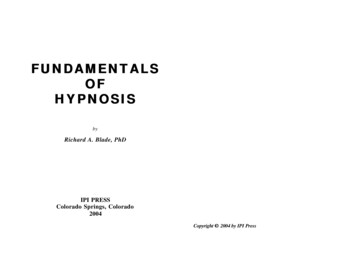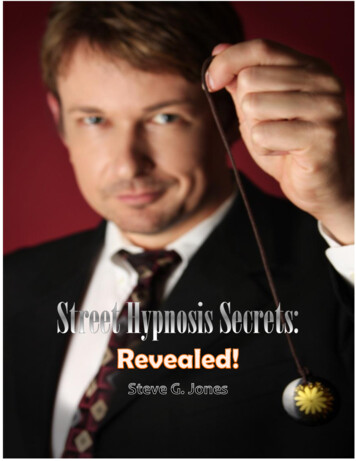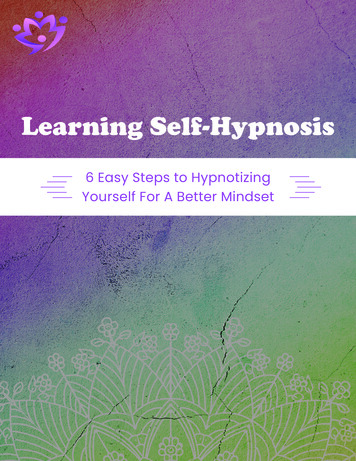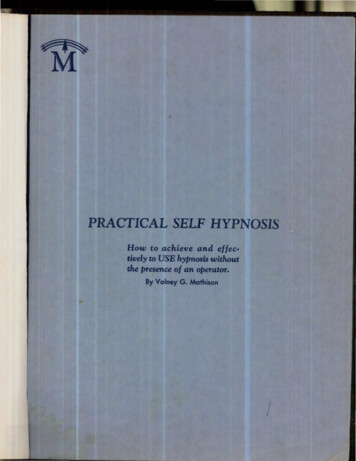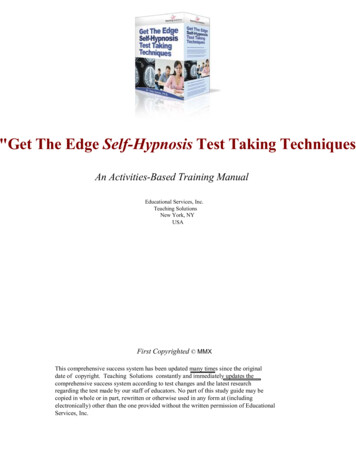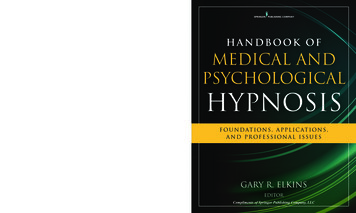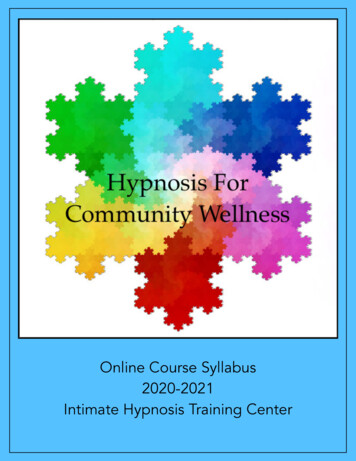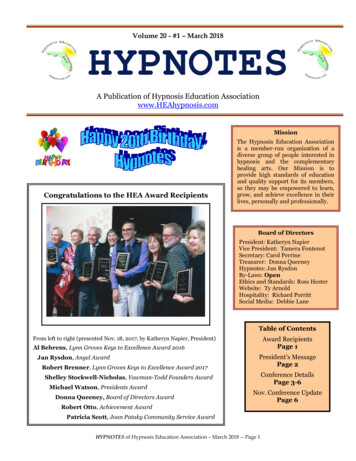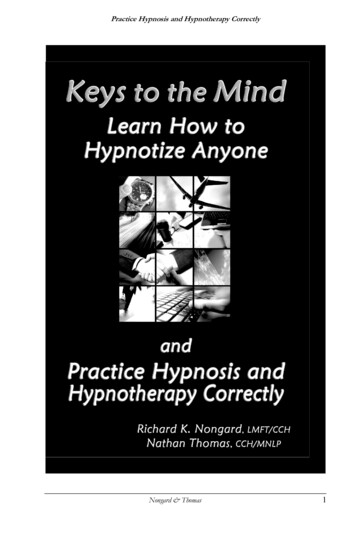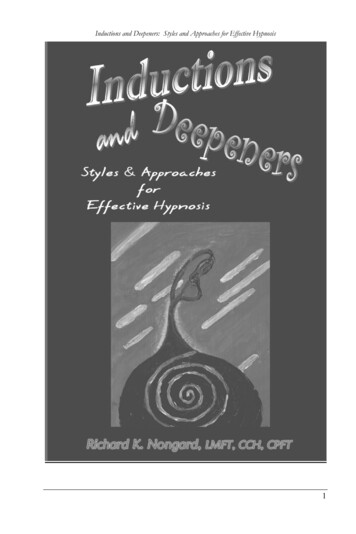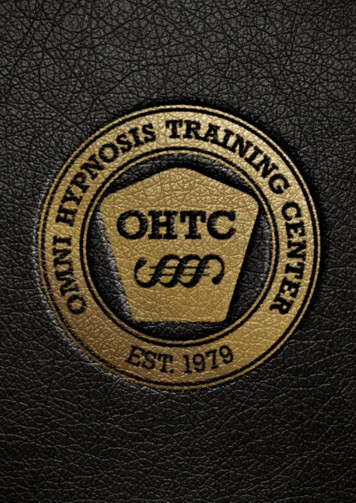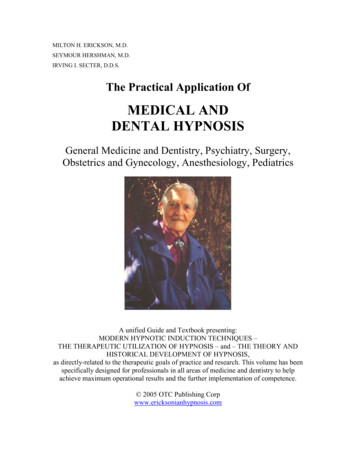
Transcription
MILTON H. ERICKSON, M.D.SEYMOUR HERSHMAN, M.D.IRVING I. SECTER, D.D.S.The Practical Application OfMEDICAL ANDDENTAL HYPNOSISGeneral Medicine and Dentistry, Psychiatry, Surgery,Obstetrics and Gynecology, Anesthesiology, PediatricsA unified Guide and Textbook presenting:MODERN HYPNOTIC INDUCTION TECHNIQUES –THE THERAPEUTIC UTILIZATION OF HYPNOSIS – and – THE THEORY ANDHISTORICAL DEVELOPMENT OF HYPNOSIS,as directly-related to the therapeutic goals of practice and research. This volume has beenspecifically designed for professionals in all areas of medicine and dentistry to helpachieve maximum operational results and the further implementation of competence. 2005 OTC Publishing Corpwww.ericksonianhypnosis.com
A statement by Milton H. Erickson, M. D. (1901-1980) Former Chairman, Board ofGovernors Seminars on Hypnosis Foundation (Predecessor of ASCH.ERF) and PastPresident and Co-Founder of ASCH."During the past several years there have been ever increasing numbers of physicians,dentists, and psychologists interested in hypnosis, both therapeutic and investigative.Reliable sources of clinical information and instruction were practically non-existentexcept for a few scattered individuals. To meet this need, to interest universities, and tostimulate medical and dental schools to an awareness of the importance of teachingclinical hypnosis, a group of experienced clinicians competent in teaching was formed.Throughout the United States, tinder the auspices of various professional societies anduniversities, this group conducted seminars on hypnosis."This book is compiled from the tape recordings of dozens of those seminars, arid thus itcontains the material as it was presented, with all the simplicity, directness andeffectiveness of the classroom presentation."It is no more, no less, than a comprehensive presentation of the material upon whichthousands of clinicians throughout the United States have based the initiation anddevelopment of their successful clinical use of hypnosis."
The Practical Application ofMedical and DentalHYPNOSISMilton H. Erickson, M.D.Seymour Hershman, M.D.Irving I. Secter, D.D.S.
PrefaceThe material in this book has been adapted from that presented in seminars throughoutthe country during the past several years. These seminars arc conducted at thepostdoctoral level, for physicians, dentists, and psychologists. 'To avoid the verbosity ofthe spoken word, some revisions have been made. For inductions and other techniques,the full flow of conversation has been preserved as transcribed from tapes, so that thereader may capture the entire sequence and interplay of events.Each of the co-authors is engaged in the active practice of his specialty. This fact isimportant because of the assurance it gives that cases presented, techniquesdemonstrated, and theoretical discussions are all based on day-to-day experience ratherthan on any purely academic approach to topics or secondhand access to clinical materialand problems.It is impossible to put into book form the full give and take that exists in an actualteaching situation. A good many of the considerations that will occur to the reader havebeen taken into account, however, in the various question and answer periods, whichhave served as a basis for supplementing the individual approaches of the co-authors.There is no adequate substitute for actual participation in an active interpersonal trainingsituation. This book is not intended as a substitute and it will have limited usefulnesswhen employed alone. As a supplement to and preparation for actual training, it doesserve important needs, not the least of which is that students can be relieved of the needfor taking notes, and feel free to participate fully and actively in the training situation.Seminars and texts can serve only as beginnings in the training of individuals for theemployment of hypnosis in their specialties. Beyond that point, it is essential for eachstudent to practice, analyze, discuss with others, and gain as extensive and intensiveexperience as possible. Where two or more students are close enough to meetoccasionally, the interaction of experiences and outlooks will help to provide continuingtraining and advice, either formally or through informal groups.Clearly, no seminar or single text can provide basic training for the internist,obstetrician, gynecologist, anesthesiologist, dentist, oral surgeon, psychologist, or
psychiatrist. It is necessary to assume that each specialist has his basic training and thento demonstrate methods and approaches by which he can apply his special training to theareas benefited by the employment of hypnosis. Inevitably, the various discussions ofproblems in any given specialty have overtones that also apply to others. Each specialistwho seeks to employ hypnosis is dealing with people and with the problems of humannature. Regardless of the specialty involved, people are people and certain generallessons are applicable in many fields.Since hypnosis is a psychologic technique, the more experience and knowledge itspractitioners have of human nature and the psychodynamics of human behavior, the moreeffectively they will use it. A good deal of attention has therefore been paid to thenuances of psychodynamic interaction. In the long run, everyone using hypnosis in thehealing arts will find that lie needs to gain a good deal of familiarity and facility in thisarea. If he observes the psychologic processes that are activated when lie employshypnosis, he will achieve definite gains on that basis alone. How much further he can godepends on personal incentives and supplementary study of psychologic and psychiatricliterature.
Contents1Outline of History and Theory of Hypnotism2Suggestion and Hypnotizability3The Phenomena of Hypnosis4Induction Techniques5Clinical Applications of Surgical Anesthesia6Hypnosis in Obstetrics7Hypnosis in Children8Clinical Applications of Hypnosis to General Medicine9Clinical Applications of Hypnosis to Psychiatry10Hypnosis in Dentistry11Hypnosis in PsychologyReferences of InterestIndex
1Outline of History andTheories of Hypnosis
Hypnotism is as old as time and probably originated when man first crawled out of theprimeval mud. It has been employed for centuries in one form or another in all parts ofthe world. Primitive societies still use the "beat-beat-beat of the torn-torn" and ritualisticdances and tribal rites to induce a trancelike state similar to hypnosis. There are evenseveral hundred references to the apparent use of hypnotic-like methods in the Bible. Forinstance, the laying on of hands to obtain cures was well known during the time of Christ.The king's "royal touch" or divine healing during the Middle Ages is another form ofhypnosis. Receptive and suggestible individuals eagerly sought to have the godlike figuretouch them and the hypnotic state was induced in a matter of seconds. In the Orient, yogais still another form of hypnosis. Yoga uses breathing and postural exercises to effectphysiologic responses in the body. The Greek and Egyptian priests used hypnosis overtwo thousand years ago in the treatment of various ailments.Modern historyThe modern history of hypnosis began with Franz Mesmer in 1773. Mesmer worked withthe Jesuit priest, Maximilian Hell, who was the royal astronomer in Vienna. They usedmagnets in the treatment of several cases of hysteria. Hell thought that the magnet curedbecause of its physical properties, while Mesmer believed that the cures were producedby a redistribution of some sort of fluid, which he called animal magnetism to distinguishit from mineral magnetism, Later he abandoned the use of magnets, since his doctrinewas continually misunderstood. Many people thought that he attributed his cures tomineral magnetism.Mesmer later observed Father Gassner obtain cures by the laying on of hands and bymaking passes over the subject's body. In 1775, Mesmer expressed the opinion thatGassner was using animal magnetism without knowing it. Gassner's bishop soon forbadeany further manipulation of this kind.Mesmer then elaborated on Gassner's technique. He postulated that a fluid circulatingin the body was influenced by the magnetic forces originating from astral bodies. Thetheory sounded scientific at the time. It coincided with the discovery of electricity and
advances in astronomy. Mesmer later contended that he, himself, had this force and thatpatients could be cured when the magnetic rays flowed from his fingers.Public pressure forced him to leave Vienna, and he moved to Paris in about 1778.There, he developed a bath-like structure, or "bacquet," lined with iron filings andmagnets. When a patient entered the bath, he "recovered" from his ailment. Neurotics,neglected by their well-meaning physicians, flocked to Mesmer's salon from all overEurope. He developed a large following with a very high percentage of cures. He alsoestablished a tremendous reputation that incurred the animosity of his colleagues. In1784, the French Academy appointed a committee consisting of Benjamin Franklin,Lavoisier the chemist, Dr. Guillotin, the inventor of the guillotine, and others toinvestigate Mesmer.The commission found that certain persons, supposedly very sensitive to animalmagnetism and capable of experiencing convulsive reactions when they touched treesthat had been magnetized by stroking, could not tell which trees in an orchard had beenmagnetized unless they saw the magnetizing performed. If they were told that a tree hadbeen magnetized, they could have convulsions when they touched it. The commissiondeclared that the effects attributed to animal magnetism were the results of imaginationand denounced Mesmer as a fraud. He subsequently fell into disrepute. These scientistsfailed to recognize, however, that suggestion resulting in strong rapport was actuallyresponsible for the so-called cures. Though Mesmer was discredited, he actually laid thefoundation for modern dynamic psychiatry. His investigations led to a betterunderstanding of the relationship of suggestion to psychotherapy.Interest in Mesmerism was revived by Dr. Elliotson, Professor of Medicine atUniversity College, London, the physician who, in 1838, introduced the stethoscope toEngland. Dr. Elliotson was asked to resign from his college and hospital appointmentsbecause of his profound interest in Mesmeric phenomena. After his resignation, he andothers carried on their research on Mesmerism. They published their findings in a journalentitled Zoist.In 1841, another English physician, James Braid, who had originally opposedMesmerism, became interested in the subject. He stated that animal magnetism was notinvolved in the cures; that they were due to suggestion. He developed the eye-fixation
technique of inducing relaxation and called it "hypnosis." Since he initially thought thathypnosis was identical with sleep, he used the term hypnos front the Greek word for"sleep." Later, after he recognized his error, he tried to change the name to monoeidismo,meaning concentration on one idea. The term "hypnosis" has persisted despite the factthat it is technically a misnomer.In 1845 James Esdaile, a surgeon, working in the back woods of India, performedhundreds of major and minor surgical procedures on natives under Mesmeric anesthesia.Esdaile's book, Mesmerism in India, (Esdaile, James, Hypnosis in Medicine and Surgery:originally entitled Mesmerism in India. New York: Julian Press, Inc., 1957) published in1850, describes over two hundred and fifty surgical operations, many of them extremelyformidable ones, such as amputations of the leg, removal of huge scrotal tumorsweighing from eighty to a hundred and twenty pounds, amputation of the penis, and othercomparable surgery. He accurately described many of the phenomena of hypnosis as weknow them. Even today this volume is a valuable scientific document. Like present-dayinvestigators, he noted the diminution of surgical shock in his hypnotic patients. He or hisnative assistants mesmerized the subjects early in the morning and left them in acataleptic state. Esdaile then went about his business, later returning and swiftlyoperating. His cases were all documented and observed by local dignitaries andphysicians. When Esdaile returned to England and related his experiences, however, hewas ridiculed and ostracized by his colleagues. He went to Scotland and eventuallyreported many more surgical successes. It is interesting to note that he remarked in hisbeautifully written book that it was difficult both to convince people of the validity of hiswork and to fight public opinion. These words are equally true today.Concurrently, in Nancy, France, Dr. Ambroise-Auguste Liebault, a French physician,read about Braid's work and became interested in hypnosis. In order to avoid beingbranded a charlatan, lie worked without financial remuneration. His results were noticedby Hippolyte Bernheim, a famous neurologist, who taught at the medical school.Bernheim sent Liebault a patient suffering front sciatica, whom he had unsuccessfullytreated for over six years. Liebault cured him with several sessions of hypnosis. Thisinterested Bernheim in Lidbault's work and together they treated over ten thousandpatients. Bernheim wrote the first scientific treatise on hypnosis, Suggestive
Therapeutics, in 1886. This belongs on any reading list dealing with the historicaldevelopment of hypnotism.In France, hypnosis encountered a very serious obstacle in the person of Charcot,another French neurologist, who disagreed with Bernheim's and Liebault's ideas thatsuggestion was the important factor in hypnosis. Charcot contended that hypnosis wasjust another manifestation of hysteria. In a decade, he found only a dozen cases of "majorhypnotism." His experiments were performed mainly on three subjects who werehysterics. Charcot revived Mesmer's theory of animal magnetism and a bitter controversyraged between the two schools of thought. History has proved that Charcot was wrongand Bernheim and Liebault correct. At this time many other famous scientists such asBroca, Heidenhain, Krafft-Ebing, and others became interested in the subject ofhypnotism.Freud heard of Liebault's and Bernheim's work and in 1890 came to Nancy. He hademployed hypnosis with Breuer, a physician who was interested in using this techniqueon mentally disturbed individuals. Freud wanted to develop his own hypnotic techniques;he studied with Charcot and Bernheim. For his purposes, he found the cures toosuperficial and therefore abandoned the method. Freud's rejection of hypnosisunfortunately retarded this field for over fifty years. There is some basis for the beliefhowever, that Freud developed his penetrating insights into human behavior and theworkings of the mind from his early work with hypnosis. He found, too, that hypnotismwas a very helpful tool for recovering buried memories.Because of the tremendous incidence of shellshock among soldiers during World WarI, Ernst Simmel, a German psychoanalyst, became interested in using hypnosis for thetreatment of war neuroses. He developed a technique that he called hypnoanalysis. Herefor the first time the use of hypnosis was combined with psychodynamic techniques.Hadfield and Horsley, working independently, and later Grinker and Spiegel duringWorld War II, used barbiturates to induce a state of drug hypnosis (narcosynthesis) inorder to bring traumatic material to the surface. During the last war hypnosis played aprominent part in the treatment of combat fatigue and other neuroses.The merger of hypnotic techniques with psychoanalysis was one of the most importantmedical developments to come out of World Wars I and II. World War I revived a great
deal of interest in hypnosis in the United States. Hull, a psychology professor at Yale,became interested in the experimental aspects of hypnosis. His data and observations aredescribed in his book, Hypnosis and Suggestibility.¹ Since then many books haveappeared on this subject and at present hypnosis is on the march. Several schools such asthe University of California, Long Island University, Roosevelt University, TuftsUniversity, and others are teaching hypnosis in this country. These are not enough, but atleast a start has been made. It is gratifying that more physicians and dentists arebecoming interested in this age-old science. Recently the British Medical Association,after a thorough investigation of hypnosis, decided that all medical students andphysicians should be well grounded in the fundamentals of hypnotherapy, thathypnotherapy is a very valuable technique in the treatment of neuroses and for anesthesiain Obstetrics and surgery. Similarly, the American Medical Association has recentlyendorsed the use of hypnosis by qualified medical practitioners.Current developmentsIn 1956 a committee of the American Medical Association met to consider how hypnosiscould be integrated into medical teaching and reported their findings in the Journal ofSeptember 13, 1958.² A number of other leading medical journals have also publishedarticles on hypnosis. There are now several journals devoted exclusively to theexperimental and clinical applications of hypnosis, (1) The American of ClinicalHypnosis, (2) British Journal of Medical Hypnotism, and (3) The Journal of Clinical andExperimental Hypnosis, and two journals in Spanish.It is interesting to note that from time immemorial hypnosis has masqueraded under amultiplicity of labels. At the turn of the century there was the Janet method of relaxation,the Pierce method, and the DuBois method. More recently, there was Jacobson'sprogressive relaxation. At present, autoconditioning and autogenic training are verypopular in Germany. Other convenient labels for hypnoanesthesia are the RussianPsychoprophylactic Relaxation and Read's Natural Childbirth.
It is believed that the approach of the faith healer embodies various fortes of hypnoticsuggestions. References to this method of relaxation are noted in the literature.TheoriesSome brief mention should be made concerning the various theories of hypnosis. In artoperational definition, hypnosis may be viewed as an increased susceptibility tosuggestion, as a result of which sensory and motor capacities are altered in order toinitiate appropriate behavior. The difficulty with most theories is that they do not separatethe trance induction process from the actual phenomena resulting from the hypnotic state.They are different entities. In hypnosis, the concern is with a segment or phenomenon ofbehavior that cannot be separated from the total realm of human behavior. Whether doneconsciously or unconsciously, man has used suggestion and/or hypnosis long before hewas ever aware of it. Hypnosis is a part of everyday life. Many persons have beenhypnotized thousands of times, although they may not have recognized this fact. Forexample, a fisherman sitting in his boat and fishing for several hours may find that theshimmering and dancing of the water lulls him into a sort of reverielike state. A mail mayglance at his watch and make the statement, "My goodness, have I been here for six oreight hours? Why, it seemed like only three or four to me." Any repetitious visual,auditory, tactile, olfactory, or gustatory sensation can induce a state of increasedsusceptibility to suggestion. Verbal and nonverbal stimuli can readily produce relaxationwhen the stimulus is repetitiously maintained. Many a person has memories of sitting in aclassroom while the professor droned monotonously on and on. He may recall that therewere times when his eyes got very heavy and his head began to nod, and he actually wentinto a hypnoidal state. This often merged into actual sleep. Awareness can fluctuate upand down the entire broad spectrum of consciousness.Hypnosis and susceptibility to suggestion play an important role in everyone's life,especially in advertising. A radio or TV commercial, repeated over and over again, caneventually become a conditioned stimulus ultimately affecting behavior toward thedesired response.
In some individuals, the hypnotic state may be an atavism, analogous to the inanimatestate of catalepsy commonly observed in frightened animals when they "freeze to thelandscape" in order to escape detection. The presence of a highly evolved cortex in thehuman now makes unnecessary the various instinctive defense mechanisms, unless theindividual is subjected to inordinate fear or danger. In some the atavistic tendency iscloser to the surface than in others. It accounts for the fact that some individuals arereadily hypnotizable while others are not.Schneck likewise believes that the state of hypnosis is a return to a very primitivelevel of psychophysiologic functioning and is present in all living animals, especially thehuman.Hypnosis can be observed throughout the animal kingdom. A snake hypnotizes a birdby its sinuous movements. In turn a snake can be hypnotized by stroking. Strangelyenough, snakes are deaf. All of us have seen pictures of or heard about the flute playerwho "charms" the snake into a sort of hypnotic-like state. Actually, it is his to-and fromotions that cause the induction of a hypnotic-like state in the snake. Animal hypnosishas been well described. Anyone who has ever been on a farm knows that he can place achicken on the ground and draw a line next to the eye closest to the ground, and thechicken will develop a tonic immobility of the limbs. A butcher who puts a chicken'shead under its wing can observe the immediate extensor rigidity of the chicken's limbs.The chicken lies immobile. This is a form of animal hypnosis.It is important to emphasize that hypnosis is riot a state of sleep. This is evidenced byelectroencephalographic studies and tests of reflexes, circulation time, and bloodpressure, which reveal themselves as identical to the waking state but different from thesleep state of the same individual. Both hypnosis and sleep are altered states ofawareness. One may merge into the other. The closing of the eyes, often associated withhypnosis, is used to blot out visual stimulation; as a result, there is concentration on theoperator's verbalizations. This is a common phenomenon. Music lovers at a concert whowish to concentrate put their heads back and close their eyes to hear better.At present, conditioned reflexology, which is yet another term for hypnosis, is verypopular in the Soviet Union. Pavlov, the great Russian physiologist, is probably as wellknown to the Russian scientists for his research on hypnosis as he is for his work on
conditioned reflexes. Pavlov says it is true that words and ideas acquire a conditionedMeaning for us. Conditioning is only a part of hypnosis, however, and both this conceptand Pavlov's idea of cortical inhibition are really too simple to explain the hypnoticphenomenon. Pavlov also erred in his assumption that hypnosis was a modified form ofsleep.Another theory propounded by Ferenczi, the psychoanalyst, was that hypnosis was aregression to infancy. Where one used a permissive technique, this was called a maternaltype of hypnosis. Ferenczi believed that the individual being hypnotized was merelyregressing to infancy in a sort of dependent child-parent relationship. This theory is nottenable, as was pointed out by McDougall.³ If it were true, a woman could be expected tohypnotize only those who resembled her mother and a man only those resembling hisfather. Hypnosis does not work that way.Robert White thinks that the subject in hypnosis acts as the hypnotized person thinks heshould act. He refers to this as "meaningful goal-directed striving." For the induction ofthe trance, this might be true to some extent, but it dues not explain how a child, whoknows nothing about meaningful experiences, can go into a hypnotic state and manifestmost of the phenomena of hypnosis. Nor does it explain how an adult can be regressed toinfancy or even to the age of one or two. The validity of the regression can besubstantiated by elicitation of the Babinski reflex, which occurs only during the first yearof life. 4Still another theory is Janet's, in which he contends that a part of the personality issplit off to produce dissociation. This, too, fails to explain other types of behaviormanifested in hypnotic subjects. Not all individuals arc dissociated. Hypnosis can beinduced by sensory modalities other than words, namely, by nonverbal, extraverbal, andintraverbal stimuli or communication processes. Anyone listening to a speaker is in twoway communication with the speaker, evaluating the intonation of his voice, his gestures,his demeanor, and the listener's own response to all these. ''Analyzers" in the brain areconstantly predicting or assessing what we feel, see, or hear. These "analyzers" correct orovercorrect stimuli from without and within. They are, as in electronics, known as feedback mechanisms. There is a continual process of communication going on at all timesbetween individuals and with the total environment. Words and gestures and other stimuli
can be interpreted only in terms of past memory experiences. Actually, hypnosis, whichfacilitates learning processes, becomes a very powerful control mechanism in thepresence of good rapport, for it enables suggestions to be accepted uncritically. Thisaffects responses in the organism.Finally, the basis for understanding the very nature of hypnotic responses certainlyrequires a knowledge of human nature. We are interested in explanations of hypnosisitself, but we arc concerned even more with an understanding of how it fits into theframework of all human behavior.¹ Hull, C. L. Hypnosis and Suggestibility. New York: D. Appleton-Century, 1933² General practitioners, medical specialists, and dentists might find hypnosis valuable as a therapeuticadjunct within the specific field of their professional competence. It should be stressed that all those whouse hypnosis need to be aware of the complex nature of the phenomena involved.Teaching related to hypnosis should be under responsible medical or dental direction, and integratedteaching programs should include not only the techniques of induction but also the indications andlimitations for its use within the specific area involved. Instructions limited to induction techniques aloneshould be discouraged.Certain aspects of hypnosis still remain unknown and controversial, as is true in many other areas ofmedicine and the psychological sciences. Therefore, active participation in high-level research by membersof the medical and dental professions is to be encouraged. The use of hypnosis for entertainment purposesis vigorously condemned.³ McDougall, William. Outline of Abnormal Psychology. New York: Charles Scribner's Sons, 1926, pp.132-34.4(Gidro-Frank, L., and Bowersbuch, M. K.: "A Study of the Plantar Response in Hypnotic AgeRegression," J. Nerv. & Ment. Dis. 107: 443, 1948)
2Suggestion andHypnotizability
The preceding material has been leading to the practical applications of hypnosis. Beforethis matter can be considered, an understanding of the relationship of suggestion andhypnotizability will be required. Pertinent in this regard is a paragraph from an articlewritten by Heron of the University of Minnesota, entitled "Principles of Hypnosis,"published in the Southern Medical Journal. In this he says, in essence, that everyone,whether as a layman or as a professional man, spends a good portion of his waking timeendeavoring to control certain segments of the behavior of other persons. For example,physicians and dentists are concerned with those aspects of the behavior of their patientsthat have to do with their health. Do their patients look upon them in a friendly manner?Do they accept surgery when advised? Do they follow directions on the prescriptions thatare written? Do they take more rest and sleep when they need it?There are only a few ways in which control of behavior can be attained: bymechanical means, by the use of drugs, by the use of rewards, by the use of punishment,by the use of reason and, very importantly, by the use of suggestion. It is suggestion thatis basic in hypnosis.Many attempts have been made to define hypnosis, both in terms of phenomenainvolved and in terms of possible causal mechanisms, but no definition has yetsatisfactorily answered all the questions raised by the subject matter. Bernheim advancedthe concept that suggestion is the basic factor in producing and in utilizing hypnosis.Suggestions need not be of a verbal nature only. They can occur at any sensory level.These include, of course, the olfactory, the gustatory, the auditory, the tactile, the visual,and many others.Suggestion and hypnotizability are very highly correlated. In hypnosis, repetition is animportant factor, as it is in many things, especially in learning. Initially, suggestion andrepetition can be considered of basic importance. If asked for a capsule definition ofhypnosis, one might say: suggestion and repetition. Everything else that the student learnswill be modification, amplification, variation, and explanation of these two basicingredients.To these may be added monoedism, concentration on one idea to the exclusion of allothers, as suggested by Braid, or in other words the elimination of all external stimuliexcept those needed to initiate the desired behavior. To this we may add expectant desire,
imagination, visualization, and the prestige of the operator. All these play an importantpart in the initial induction of hypnosis. Any one or any combination of these factors maybe involved in producing the hypnotic state.Bernheim pointed out that there is really no marked difference between normal actscarried out in the hypnotic state and those carried out in the normal, waking state. Theterm "normal state" might give the impression that hypnosis is an abnormal state.Actually, it is a continuum from the ordinary state of wakefulness.Furthermore, all the phenom
universities, this group conducted seminars on hypnosis. "This book is compiled from the tape recordings of dozens of those seminars, arid thus it contains the material as it was presented, with all the simplicity, di
